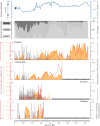A palaeoecological perspective on the transformation of the tropical Andes by early human activity
- PMID: 35249394
- PMCID: PMC8899620
- DOI: 10.1098/rstb.2020.0497
A palaeoecological perspective on the transformation of the tropical Andes by early human activity
Abstract
Palaeoecological records suggest that humans have been in the Andes since at least 14 000 years ago. Early human impacts on Andean ecosystems included an increase in fire activity and the extinction of the Pleistocene megafauna. These changes in Andean ecosystems coincided with rapid climate change as species were migrating upslope in response to deglacial warming. Microrefugia probably played a vital role in the speed and genetic composition of that migration. The period from ca 14 500 to 12 500 years ago was when novel combinations of plant species appeared to form no-analogue assemblages in the Andes. By 12 000 years ago most areas in what are today the Andean grasslands were being burned and modified by human activity. As the vegetation of these highland settings has been modified by human activity for the entirety of the Holocene, they should be regarded as long-term manufactutred landscapes. The sharp tree lines separating Andean forests from grasslands that we see today were probably also created by repeated burning and owe their position more to human-induced fire than climatic constraints. In areas that were readly penetrated by humans on the forested slopes of the Andes, substantial modification and settlement had occurred by the mid-Holocene. In hard-to-reach areas, however, the amount of human modification may always have been minimal, and these slopes can be considered as being close to natural in their vegetation. This article is part of the theme issue 'Tropical forests in the deep human past'.
Keywords: fire; manufactured landscapes; megafauna; microrefugia; migration; tree line.
Conflict of interest statement
We declare we have no competing interests.
Figures





References
-
- Balée W. 1989. The culture of Amazonian forests. In Resource management in amazonia: indigenous and folk strategies (eds Posey D. A., Balée W.), pp. 1-21. New York, NY: New York Botanical Garden.
-
- Erickson C. 2010. The historical ecology of a domesticated landscape. In Contemporary archaeology in theory: the new pragmatism, 2nd edn (eds Preucel R. W., Mrozowski S. A.), pp. 104-128. Chichester, UK: Wiley-Blackwell.
-
- Sarmiento F. 2012. Contesting páramo: critical biogeography of the northern andean highlands. Charlotte, NC: Kona Publishers.
-
- Chepstow-Lusty A, Winfield M. 2000. Inca agroforestry: lessons from the past. Ambio 29, 322-328. (10.1579/0044-7447-29.6.322) - DOI
Publication types
MeSH terms
Associated data
LinkOut - more resources
Full Text Sources
Research Materials
Miscellaneous
